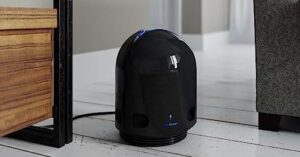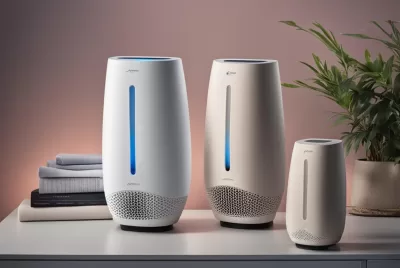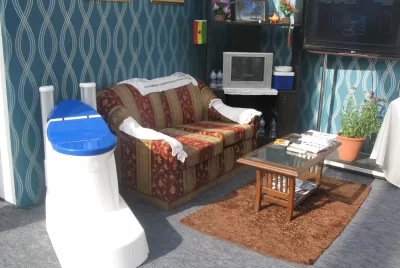Filterless Air Purifiers: A Comprehensive Guide
"We may earn a commission for purchases made using our links. Please see our disclosure to learn more."
The Real Deal About Filterless Air Purifiers:
Step into the realm of filterless air purifiers. These unassuming devices have been taking the world of air purification by storm. But why? What sets them apart from their filter-laden counterparts? Are they genuinely as magical as they sound or just a flash in the pan? Let’s pull back the curtains and dive into the depths of these fascinating machines.
Decoding Air Purifiers
When it comes to the wide universe of air purifiers, it’s easy to get lost in the jargon. You’ve got your HEPA filters, your activated carbon filters, your UV purifiers, and now, the new kid on the block: filterless air purifiers. But what do all these terms mean?
Traditional air purifiers rely on filters—usually HEPA or activated carbon—to trap and remove pollutants. They’re like giant vacuum cleaners for your air, sucking in the bad stuff and releasing the good. But what if I told you there was another way to purify air—no filter necessary? That’s where filterless technology comes in.
Do Filterless Air Purifiers Work?
So, you’re probably wondering, “How can a filterless air purifier possibly cleanse the air if there’s no filter to trap the pollutants?” Good question!
Filterless air purifiers use a variety of innovative technologies to clean the air. Some use electrostatic precipitation or ionization to give pollutants a charge, causing them to stick to a collection plate or to other particles. Others use heat sterilization to incinerate microorganisms (Thermodynamic Sterilization or TSS), and others still use UV light to kill germs. It’s like using the force of Star Wars, the heat of a dragon’s breath, or the power of sunlight in your very own living room.
But do they work? Absolutely! Many studies have shown that these technologies can effectively reduce pollutants. But like everything else in life, they aren’t perfect. Each has its strengths and weaknesses, which we’ll explore next.

Filterless Air Purifiers and Dust: A Crucial Evaluation
“Dust—ugh!” I hear you say. It’s everywhere, isn’t it? And it just keeps coming back, no matter how much you clean. But wait! What if I told you that an air purifier could be your new secret weapon in the war against dust?
Filterless air purifiers can tackle dust, but how well they do so depends on the technology they use. Electrostatic precipitators and ionizers can make dust particles stick together, making them too heavy to float in the air. It’s like giving each dust particle a little weight, causing it to fall to the floor, where you can easily vacuum it up. Isn’t that a neat trick?
Types of Filterless Air Purifiers
Let’s take a straightforward approach to understanding these various types of filterless air purifiers and identify what each one is best suited for:
- TSS (Thermodynamic Sterilization System) air purifiers: These devices heat the air to high temperatures, sterilizing it and killing microorganisms. This can be especially useful in situations where there’s a high risk of airborne disease transmission, or if you’re specifically concerned about bacteria, viruses, fungi, and other microscopic invaders.
- Ionizers: Ionizers emit negatively charged ions, which attach to positively charged particles in the air, such as dust and pollen. The charged particles are then easier to remove from the environment. This makes ionizers particularly useful for people with allergies or asthma, as they can help reduce allergens in the air. Ionizers do emit ozone, a molecule that can neutralize odors and kill bacteria. They are useful for controlling odors and can help in environments prone to bacterial growth. However, they should be used with caution, as ozone can be harmful to health in high concentrations.
- Electrostatic Precipitators: Similar to ionizers, electrostatic precipitators charge particles in the air. However, these purifiers also contain plates that attract and capture the charged particles, removing them from the air. These are beneficial in environments where dust and other particulate pollutants are a concern.
- Advanced Filterless Air Purifiers: Some newer air purifiers use multiple methods to clean the air, combining elements of the other types of purifiers. These all-in-one devices can be beneficial in environments with a range of air quality issues, as they can address multiple types of pollutants.
- Ultraviolet Air Purifiers: These purifiers use UV light to kill bacteria and viruses. They can be especially useful in healthcare settings or any environment where minimizing disease transmission is a priority.
But remember, not all filterless purifiers are created equal. Some are better at handling dust than others, and they all have their limitations. In the next section, we’ll get down to the nitty-gritty of these purifiers to help you make an informed decision. So stay tuned!
Potential Downside to Air Purifiers: An In-depth Analysis
“But wait,” you might be saying, “air purifiers can’t possibly be all sunshine and rainbows, can they?” You’re spot on! Like everything else, air purifiers, both filter-based and filterless, come with their fair share of drawbacks.
Let’s discuss a few. For one, some air purifiers, especially ionizing purifiers, can produce ozone—a lung irritant. Then, there’s the cost. Buying, running, and maintaining an air purifier can be expensive. And let’s not forget noise—some purifiers could give a lawn mower a run for its money.
When it comes to filterless purifiers, one significant issue is that while they can make pollutants stick together or fall to the floor, they don’t remove the pollutants from the room. You’ll still need to clean up to completely remove the trapped particles.
HEPA Filters: Unveiling Their Limitations
HEPA filters are the gold standard in air purification, right? They can remove 99.97% of particles larger than 0.3 microns—that’s way smaller than a human hair! But wait, is there anything these powerhouse filters can’t capture?
Despite their efficiency, even HEPA filters have their limits. They’re not so good at handling gases, odors, or chemical pollutants. And those ultra-small particles? Some of them can slip right through.
Filterless vs HEPA: A Comprehensive Comparison
So, how do filterless air purifiers stack up against HEPA? The answer depends on what you’re looking for. If you’re concerned about allergens and dust, a HEPA filter might be your best bet. But if you’re more worried about viruses, bacteria, or mold, a filterless purifier could be the way to go. Just remember, each has its pros and cons.
Filterless Air Purifiers and Smoke: Do They Hold Up?
What about smoke? Can filterless air purifiers handle the aftermath of your burnt dinner or the nearby wildfire? Some can, particularly those using electrostatic or thermodynamic sterilization technology. However, for best results, especially against odors, a combination of technologies might be your best bet. We’ll dive into the best filterless air purifiers for smoke in a future review.
Conclusion
As we wrap up our journey into the world of filterless air purifiers, we’ve seen that these novel devices certainly have a lot to offer. They’re innovative, effective, and a viable alternative to traditional filter-based systems. They aren’t without their shortcomings, but then again, what is?
The takeaway here is that the best air purifier for you depends on your specific needs and circumstances. And now, armed with the knowledge you’ve gained, you’re well-equipped to make an informed choice. Filter or filterless? HEPA or ionizer? The choice is yours.
Frequently Asked Questions
While we’ve covered a lot, I know there might still be some lingering questions. So, let’s tackle some of the most frequently asked questions about filterless air purifiers.
How effective are filterless air purifiers?
Filterless air purifiers can be highly effective, depending on the technology they use and the specific pollutants you want to tackle. While they might not trap as much dust or pollen as a HEPA filter, they can be very effective against microorganisms and some types of gases.
How do filterless air purifiers handle dust?
Air purifiers can without filters handle dust, but their effectiveness varies. Ionizing and electrostatic models can cause dust particles to clump together and fall to the floor, but the dust isn’t removed until you vacuum or clean your room.
What are the potential downsides of filterless air purifiers?
Like all air purifiers, filterless models have downsides. They can produce ozone, they don’t remove pollutants from your room, and some may struggle with certain types of pollutants, like volatile organic compounds (VOCs) or heavy smoke.
Can filterless air purifiers effectively remove smoke?
Some filterless air purifiers can effectively reduce smoke particles in the air, particularly those using electrostatic or thermodynamic sterilization technology. However, they may not be as effective at removing the odors associated with smoke.
How do filterless air purifiers compare with HEPA air purifiers?
Filterless air purifiers and HEPA purifiers both have their strengths and weaknesses. While HEPA purifiers excel at trapping large particles like dust, pollen, and pet dander, filterless purifiers can be more effective against bacteria, viruses, and mold. However, the best choice depends on your individual needs and the specific pollutants in your home.




